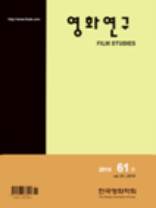- 영문명
- Cinema Novo, 1955-1971: Resisting and Subverting Reality, and Exploring the National Identity
- 발행기관
- 한국영화학회
- 저자명
- 정태수
- 간행물 정보
- 『영화연구』제61호, 297~340쪽, 전체 44쪽
- 주제분류
- 예술체육 > 예술일반
- 파일형태
- 발행일자
- 2014.09.30
8,080원
구매일시로부터 72시간 이내에 다운로드 가능합니다.
이 학술논문 정보는 (주)교보문고와 각 발행기관 사이에 저작물 이용 계약이 체결된 것으로, 교보문고를 통해 제공되고 있습니다.

국문 초록
영문 초록
During the period from 1955 to 1971, called as Cinema Novo, in thehistory of Brazilian Cinema, there was happening a something historicalscene. It was the developmental policies of President Getúlio DornellesVargas and, following this, President Juscelino Kunitschek’s policieswhich called ‘Plano de Metas’ which deepened the gap between the richand the poor, while a number of Brazilians becoming poorer. Seekingfundamentally different aims from Chanchada, big-budget epics thatimitated the style of Hollywood, Cinema Novo directly looked into suchsocial realities. Considering Chanchada films as an object to be liquidatedin the history of Brazilian cinema, the new cinema focused on screeningthe difficult situation. In addition to this, it also represented the publicexpectation of revolution and resistance against the reality. Thus, cinemawas considered as a means of reformation and revolution. A typicalexample was Glauber Rocha’s famous motto, “an idea in one’s head anda camera in one’s hand.” Such ideas on filmmaking became the startingpoint for directors of Cinema Novo which made them to go beyondscreening social problems and reach at class problems, which finallybecame a base for class conflict and revolution. However, such characteristics were to be changed fundamentally by the1964 Brazilian coup d’état. The military regime prohibited all the politicalactivities and controlled and censored all media and artistic activities. In such a situation, Cinema Novo circuitously explored crimes andirrationalities of contemporary Brazilian society rather than directly lookedinto as it did during the previous period. Moreover, it also questionedabout Brazil’s national identity, the base of which were culture theoriessuch as Cannibalism, Concretismo, and Tropicalismo that were manifestedin the commemoration of the 100th anniversary of Brazil’s independencefrom Portugal. In this paper, I have attempted to show that Cinema Novowas formed throughout such various spectrums of contents and forms.
목차
1. 개발주의와 군부정권
2. 다양한 사회이론과 새로운 영화미학
3. 현실, 저항, 전복, 민족의 정체성
4. 맺음말
해당간행물 수록 논문
- 한국영화의 해외시장 진출을 위한 콘텐츠 전략 연구
- 디지털 융합 환경에 따른 대학영화교육 패러다임의 변화에 대한 연구
- 식민지기 조선의 문화영화 개념 형성에 관한 연구
- Female Sexuality in Kim Ki-duk’s Moebius: Going Beyond Freud and Lacan
- 문학과 만나는 영화의 한 방식
- 영화제작의 리스크관리를 위한 스토리공학적 접근
- The Development of Chinese Film Industry in the Deng Era
- 영화 공간 사운드 제작연구
- 미래 영화관 개발의 대안 책으로서 <록키호러픽쳐쇼>의 영상과 퍼포먼스의 확대영화에 대한 논의
- 융합학문으로서의 ‘영화공학’의 학적 성립과 방향
- 영화연구 제61호 목차
- 디지털 특수효과로서 카메라 무브먼트(movement)에대한 고찰
- 신화적 모티브의 영화적 재구성에 관한 연구
- Wiederholte filmische Motive zur Erinnerung der Vergangenheit und ihre Bedeutung als kultursemiotischer Code im koreanischen Film
- 리좀적 탈주로써 ‘-되기’ 생성 연구
- 현실에 대한 저항과 전복, 민족의 정체성 탐구, 브라질의 시네마 누보(1955-1971)
- 철학과 물리학의 통섭적 시각으로 살펴본 영화 <마법사들>의 시⋅공간
- 1970∼80년대 민중문화운동과 한국영화
참고문헌
관련논문
예술체육 > 예술일반분야 BEST
- 생성형 AI 도구와 디자이너의 협업 프로세스 개발 - 이미지를 통한 아이디어 확산에서 고해상도 렌더링까지
- ‘일과 삶의 균형(Work-Life Balance)’ 척도 개발을 위한 연구
- 디자인 전공 교과목에서의 생성형 AI 도구 활용 사례 연구
예술체육 > 예술일반분야 NEW
- 한국영화의 촬영과 조명 시리즈 2: 영화 '형사, Duelist'의 Visual Concept 및 조명플랜
- 포스트모더니즘적 영상표현에 관한 연구 -실사 영화와 애니메이션 영화의 상호작용을 중심으로-
- 소니 HVR-Z1N 카메라의 중요한 메뉴에 관한 소고
최근 이용한 논문
교보eBook 첫 방문을 환영 합니다!

신규가입 혜택 지급이 완료 되었습니다.
바로 사용 가능한 교보e캐시 1,000원 (유효기간 7일)
지금 바로 교보eBook의 다양한 콘텐츠를 이용해 보세요!



